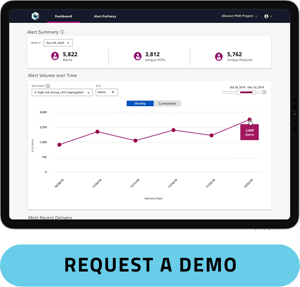The Cost of Bad Alerts

 Clinical alerts have become staples of the life sciences marketing and sales toolkit, giving both brand teams and medical teams a critical heads-up about healthcare encounters that are relevant to their particular therapeutic area – like starting a new treatment, testing for a specific diagnosis, or meeting clinical trial eligibility criteria. But all alerts are not created equal.
Clinical alerts have become staples of the life sciences marketing and sales toolkit, giving both brand teams and medical teams a critical heads-up about healthcare encounters that are relevant to their particular therapeutic area – like starting a new treatment, testing for a specific diagnosis, or meeting clinical trial eligibility criteria. But all alerts are not created equal.
Before joining Komodo, I learned this the hard way. As a former field sales rep, I was inundated with information from all angles. The usefulness of an alert depended on a number of factors, like the types of diseases being diagnosed, the path to that diagnosis, and what type of specialist made the diagnosis.
But many – perhaps even most – of the alerts I received in the field weren’t useful at all, let alone actionable. Following is a rundown of some of the most common forms of bad alerts.
Bad alert #1: A disconnected snapshot of HCP encounters
A common source of frustration is receiving a notification without enough historical context on the patient to know whether the information is actionable or not. My teams would sometimes receive an alert the moment a patient received a diagnosis without any history on that patient.
Upon closer inspection, we often found that the alert was triggered by an encounter with a primary care provider or pediatrician for a patient who was already being managed by a sub-specialist and had been on our radar for months. Sometimes they had already been placed on treatment. The team wasted valuable time and resources chasing patients who were already flagged in the system.
Simple diagnosis alerts, without the collective history of the patient’s full spectrum of encounters and history of touch points with the healthcare system, just make noise, potentially creating the illusion of new patients when they are really double-counting existing patients.
Bad alert #2: Late alerts for rare disease
Rare disease patients often go years being misdiagnosed and frustrated by their journey through the healthcare system as their illness progresses. Life sciences companies work hard to find those misdiagnosed or undiagnosed patients and help get them on the right track.
Alerts that signal a new rare disease diagnosis are often already too late to make a meaningful difference in the patient’s journey. These alerts have already missed the upstream signals – the constellation of disparate symptoms indicating a need for testing – that would have reduced time to treatment and helped the patient earlier. On top of this, often these diagnosis alerts create a false alarm that there is a new patient when, in reality, the field team is already supporting the patient. Yet the alert triggers time-consuming work for the field team as well as upper management – when ultimately the alert was redundant and late.
Bad alert #3: Pill tracking in a vacuum
Perhaps most frustrating of all is the missed opportunity – the alert that lets you know a physician just prescribed your competitor’s drug. The clues were there earlier, but, for whatever reason – incomplete data sets, data lag, or overly simplistic programming – your team only gets notified when it’s too late to make an impact.
Sure, there may be some value in the competitive intelligence, but in reality, commercial sales reps aren't particularly focused on learning about their competitor's wins in their alerts. What they really want are alerts designed to target the right HCP for productive and timely engagement to ensure that the HCP has all the information needed to make a sound treatment decision. The optimal time to engage an HCP is before they've made that treatment decision.
As a colleague of mine would say: “The only thing worse than no alert is a bad alert.”
The Komodo Health advantage
The best alerts give pharma teams the information and signals they need before a clinical decision is made, enabling them to connect with providers to make the maximum impact.
This is where Komodo has the advantage on smarter alerts.
Built on our comprehensive Healthcare Map™ of real-world patient journeys, our Pulse solution delivers relevant alerts on clinical activity at the optimal time for engagement with HCPs, which ensures communications are both timely and applicable to patients currently in their care.
Rather than fatiguing pharma teams with alarms that waste time, we alert users to “red flag symptoms” that are predictive of a future diagnosis, getting ahead of a treatment path to really make a difference in patient outcomes. Pulse alerts can lead to a more timely and productive conversation with an HCP, educating on a therapeutic area or identifying patients for a trial – all at the right time.
In this industry, finding new patients is the optimal goal, and by providing insights that are not only actionable, but helpful, we can leverage Komodo's unprecedented level of data connectivity to our advantage. By continually refining alerts as we enrich data sets with more than 15 million patient encounters each day, we can ensure that the information we’re disseminating is timely, actionable, and in-context. That’s the game changer we’re all looking for.
Learn more about Pulse here.




